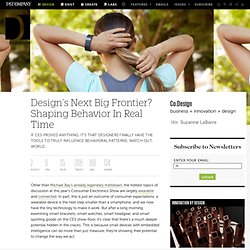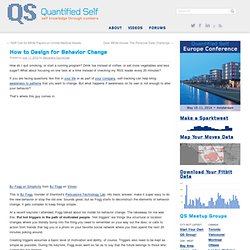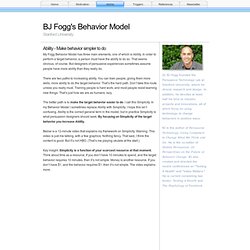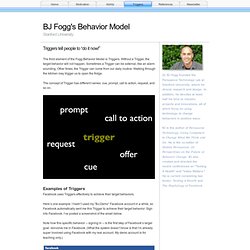

Design's Next Big Frontier? Shaping Behavior In Real Time. Other than Michael Bay's already legendary meltdown, the hottest topics of discussion at this year's Consumer Electronics Show are largely wearable and connected.

In part, this is just an outcome of consumer expectations: a wearable device is the next step smaller than a smartphone, and we now have the tiny technology to make it work. But after a long morning examining smart bracelets, smart watches, smart headgear, and smart sporting goods on the CES show floor, it’s clear that there’s a much deeper potential hidden in the cracks. This is because small devices with embedded intelligence can do more than just measure; they’re showing their potential to change the way we act.
The idea of using technology to change behavior is something we've been hearing about for a few years now, in articles talking about the surprising effectiveness of "Your Speed" radar boxes on the side of the road, or the subtle tricks video games and social networking sites use to encourage certain actions. How to Design for Behavior Change. How do I quit smoking, or start a running program?

Drink tea instead of coffee, or eat more vegetables and less sugar? What about focusing on one task at a time instead of checking my RSS reader every 20 minutes? If you are facing questions like this in your life or as part of your company, self-tracking can help bring awareness to patterns that you want to change. But what happens if awareness on its own is not enough to alter your behavior? That’s where this guy comes in. BJ Fogg on Simplicity from BJ Fogg on Vimeo. This is BJ Fogg, founder of Stanford’s Persuasive Technology Lab. At a recent keynote I attended, Fogg talked about his model for behavior change. Creating triggers assumes a basic level of motivation and ability, of course. Another fascinating part of Fogg’s model is his Behavior Grid, which outlines 15 ways behavior can change, and the paths you can take to get to the result you want. Behavior Model - Ability. My Fogg Behavior Model has three main elements, one of which is Ability.

In order to perform a target behavior, a person must have the ability to do so. That seems obvious, of course. But designers of persuasive experiences sometimes assume people have more ability than they really do. There are two paths to increasing ability. You can train people, giving them more skills, more ability to do the target behavior. The better path is to make the target behavior easier to do. Below is a 12-minute video that explains my framework on Simplicity. Key insight: Simplicity is a function of your scarcest resource at that moment. Behavior Model - Motivation. My Behavior Model highlights three Core Motivators: Sensation, Anticipation, and Social Cohesion.

Each of these has two sides: pleasure/pain, hope/fear, acceptance/rejection. The Core Motivators apply to everyone; they are central to the human experience.To illustrate my concept of Motivation, I took the photographs below in Oslo’s Vigeland Sculpture Park. Sensation is a Core Motivator Anticipation is a Core Motivator Social Cohesion is a Core Motivator. Behavior Model - Triggers. The third element of the Fogg Behavior Model is Triggers.

Without a Trigger, the target behavior will not happen. Sometimes a Trigger can be external, like an alarm sounding. Other times, the Trigger can come from our daily routine: Walking through the kitchen may trigger us to open the fridge. The concept of Trigger has different names: cue, prompt, call to action, request, and so on. Examples of TriggersFacebook uses Triggers effectively to achieve their target behaviors. Here’s one example: I hadn’t used my “BJ-Demo” Facebook account in a while, so Facebook automatically sent me this Trigger to achieve their target behavior: Sign into Facebook. Note how this specific behavior -- signing in -- is the first step of Facebook’s larger goal: reinvolve me in Facebook.
Three Types of Triggers My Behavior Model names three types of triggers: Facilitator, Signal, and Spark. Look at the Facebook example above. An effective Trigger for a small behavior can lead people to perform harder behaviors.